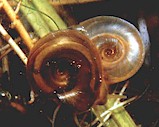Flukes are parasitic worms belonging to the group of the trematodes. All the trematode species (estimated to be more than 20'000 worldwide) are obligate parasites of either mollusks or vertebrates, including livestock and other domestic animals, as well as humans. Flukes and tapeworms belong to the flatworms (also called Platyhelminthes).
All flukes parasitic of domestic animals are internal parasites, i.e. they spend part of their life-cycle inside their hosts (i.e. they are endoparasites).

Flukes have mostly a flat body, with an oval or worm-like form, have no external signs of segmentation and are relatively short (max. about 10 cm). Most flukes have two suckers for attaching to the host, one close to the mouth and on the ventral side. They have a blind digestive system, i.e. without exit: the only opening is the mouth. But it is often not linear, as in most animals, but branched, ending in several blind ducts (called coeca).
Most flukes are simutaneous hermaphrodites, i.e. they have both male and female reproductive organs. The genus Schistosoma is an exception with both male and female worms.
Infections with flukes are called trematodosis.
As a general rule, flukes can be seriously harmful to grazing livestock, especially sheep, but also cattle, particularly in humid regions that offer an adequate environment for the intermediate hosts. Flukes can occur in traditional pig and poultry production, but are usually not an issue in industrial operations.
Flukes are seldom a problem for pets, especially in urban environments nor for horses. In fact, there are almost no veterinary medicines for controlling flukes on dogs, cats or horses, very few for pig and poultry, but numerous brands for sheep and cattle.
You can find additional general information in this site on parasites and on parasitic worms.
Life cycle of flukes

Flukes have complex indirect life-cycles that require the passage through one or more intermediate hosts (typically snails and other mollusks, insects) where the various developmental stages suffer considerable morphologic changes. In contrast with roundworms and tapeworms immature flukes can reproduce asexually (polyembryony), i.e. a single egg can originate several adults.
Usually fertilized eggs of flukes leave the final host through the feces. Each egg produces one larva capable of swimming in an aquatic environment, called miracidium. Such larvae find a suitable intermediate host (usually a mollusk, often snails) and actively penetrates into it.
Inside the snail the miracidium develops to the next stage, the sporocyst. The sporocyst produces a redia (larva with a mouth sucker) or more sporocysts. Rediae produce either more rediae or a cercaria, another larval form that is motile and usually leaves the intermediate host to find a final host (e.g. mammals). Still outside, a host cercariae can encyst and form metacercariae that are quite resistant to climatic changes. Both cercariae and metacercariae can infest livestock and pets. One in the final host cercariae will migrate to their preferred locations, complete development to adult flukes and reproduce.
There are numerous deviations to this developmental pathway. E.g. cercariae from Dicrocoelium dendriticum, the lancet liver fluke, are eaten by ants that act as a second intermediate hosts, where they develop to metacercariae. Livestock swallow infected ants while grazing. Another deviation are species of the genus Schistosoma, whose cercariae swim freely in water and actively infect livestock through the skin.
Fluke species of veterinary importance
In the following those fluke species are listed that are most relevant for cattle, sheep and other livestock as well as for horses, dogs and cats. For each species the final location and most affected hosts are mentioned. For specific articles on each species clik the corresponding link in the list below.
- Alaria spp: small intestine; affects dogs and cats, occasionally pigs and poultry
- Dicrocoelium spp: lancet flukes; bile ducts and gall bladder; affects cattle, sheep, goats, occasionally pigs, horses, dogs and cats
- Eurytrema pancreaticum: the pancreas fluke; pancreatic ducts; affects cattle, sheep, goats, pigs
- Fasciola hepatica: the common liver fluke; biliary ducts and gallbladder; affects cattle, sheep, goats, occasionally pigs, horses, dogs and cats
- Fasciola gigantica: the tropical liver fluke; biliary ducts and gallbladder; affects cattle, sheep, goats, occasionally pigs, horses
- Fascioloides magna: the giant liver fluke; liver; affects cattle, sheep, goats.
- Gastrodiscus aegyptiacus: the equine intestinal fluke; small intestine; affects horses and pigs
- Heterobilharzia americana: the dog schistosome; mesenteric veins; affects dogs
- Opisthorchis felineus: the cat liver fluke; hepatic and biliary ducts; affects cats and occasionally dogs
- Paramphistomum spp: sstomach or rumen flukes; stomach and small intestine; affects cattle, sheep, goats
- Prosthogonimus spp: oviduct flukes; oviduct, bursa of Fabricius; affects poultry
- Schistosoma spp: blood flukes; blood vessels; affects cattle, sheep, goats, cats, and horses